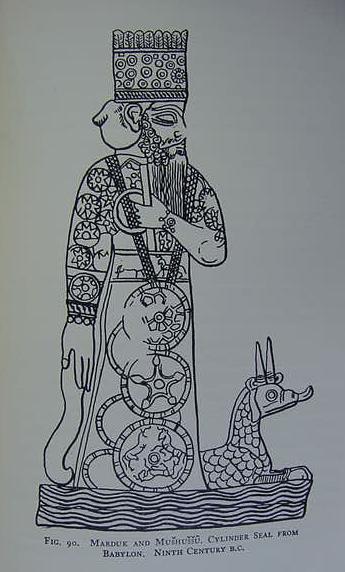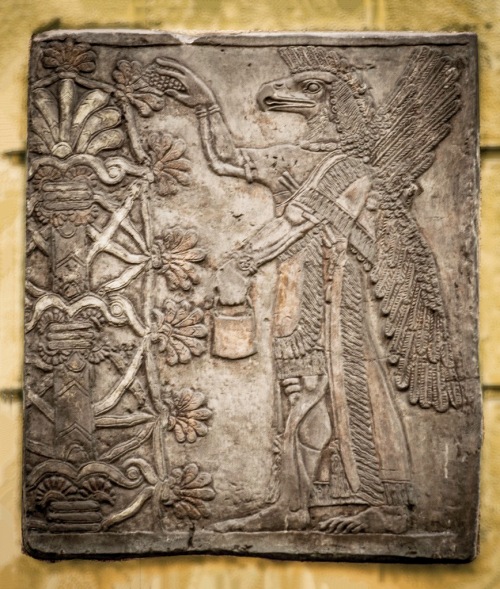Kvanvig: Assurbanipal Studied Inscriptions on Stone from Before the Flood
“The first thing to notice is the strange expression salmīšunu, “their images.” The pronoun refers back to the primeval ummanus / apkallus. They had “images,” created by Ea on earth. A line from Bīt Mēseri sheds light on the issue.
šiptu šipat Marduk āšipu salam Marduk
“The incantation is the incantation of Marduk, the āšipu is the image of Marduk.”
(Bīt Mēseri II, 226. Cf. Gerhard Meier, “Die zweite Tafel der Serie bīt mēseri,” AfO 14, 1941-4, pp. 139-52, 150).
In his role as exorcist, the āšipu is here an image of the deity itself. In the Poem of Erra something similar must have been thought. The āšipu and other priests with responsibility for the divine statues were the earthly counterparts of the transcendent ummanus / apkallus. They were their images on earth.

“Sometimes animal hybrids … appear to take part in rituals….some types are clearly minor deities, since they wear the horned cap as a mark of their divinity…others may be human. A …winged god, standing or kneeling, holds a bucket and cone … in the scenes of “ritual” centered on the stylized tree. A similar female figure holds a chaplet of beads….A third figure carries a flowering branch, sometimes also a sacrificial (?) goat. Sometimes he wears the horned cap, and even when does not he often has wings. Presumably, therefore, such figures are also non-mortal; they may represent the Seven Sages in human guise.”
From Jeremy Black and Anthony Green, Gods, Demons and Symbols of Ancient Mesopotamia, 1992, pp. 86-8.
We must admit that the following text from line 34 is not very clear. Does the ummanus from line 34 mean the primeval apkallus, or does it refer to the priests as ummanus? If we follow the interpretation underlying Foster’s translation, the second option is preferable.
“He himself gave those same (human) craftsmen
great discretion and authority;
he gave them wisdom and great dexterity.
They have made (his) precious image radiant,
even finer than before.”
(Poem of Erra II, pp. 34-6. Foster, Before the Muses, p. 892).
The text thus describes how Ea equips the earthly ummanus with wisdom and dexterity to make them able to restore Marduk’s statue.
To care for the divine statue, to make sure that it is qualified for the manifestation of the divinity, is to secure cosmic stability. This was the great responsibility of the āšipu when they acted as earthly images of the apkallus, the guardians of the cosmic order.

Marduk, the supreme god of Babylon. At his feet the Mushhushshu Serpent-dragon, which he overpowered when he defeated Tiamat, mother of the gods, who sought to destroy the land-dwelling gods.
In this myth the Serpent-dragon was a creature of Tiamat’s (for the image cf. p. 301. Stephen Herbert Langdon. The Mythology of All Races- Semitic. Vol. 5. Boston. Marshall Jones Company. 1931).
This drawing is after a 9th century BCE Babylonian cylinder seal. The Assyrians later declared their God Asshur as the god who defeated Tiamat, and Marduk’s serpent-dragon was portrayed as accompanying Asshur.
Marduk’s robe depicts the heavenly night sky with all its stars.
I believe that the circular medallions hanging from his neck are among the few portrayals of the me, the tablets of destinies, in all Assyrian art.
Marduk was also called “the son of the Sun,” “the Sun” and “bull-calf of the Sun” (Babylonian amar-utu).
http://www.bibleorigins.net/SerpentDragonMardukAsshur.html
The supreme responsibility on earth for cosmic stability rested on the king. Therefore the king needed to be depicted as wise, having insight into the hidden laws of the cosmos. This is a reoccurring topic in descriptions of kings and their own self-presentations.
It reaches as far back as the third millennium, but shows an increasing tendency in the first millennium.
(Cf. R.F.G. Sweet, “The Sage in Akkadian Literature: A Philological Study,” in The Sage in Israel and the Ancient Near East, eds. J.G. Gammie and L.G. Perdue, Winona Lake, 1990, pp. 45-65, 51-7).
In their boasting of superior wisdom the kings of the first millennium compared their own wisdom with the wisdom of the primary apkallu, Adapa:
“Sargon claims to be: “a wise king, skilled in all learning, the equal of
the apkallu, who grew up in wise counsel and attained full stature in good judgement.”
(Cylinder Inscription, 38. Cf. David Gordon Lyon, Keilschriftentexte Sargon’s Königs von Assyrien, (722-705 v. CHR), AB. Leipzig, 1883, pp. 34-5. Translation according to Sweet, “The Sage in Akkadian Literature,” p. 53).
“Sennacherib presents himself as one to whom “Ninšiku gave wide understanding and equality with the apkallu, Adapa, and granted profound wisdom.”
(Bull Inscription, 4. Cf. D.D. Luckenbill, The Annals of Senacherib, Chicago, 1924, p. 117; translation according to Sweet, “The Sage in Akkadian Literature,” p. 53).
Prism of Sennacherib, the Oriental Institute at the University of Chicago.
Daniel David Luckenbill, The Annals of Sennacherib, University of Chicago Press, Chicago, 1924.
https://oi.uchicago.edu/sites/oi.uchicago.edu/files/uploads/shared/docs/oip2.pdf“Assurbanipal describes his comprehensive wisdom in the following way:
“Marduk, the apkallu of the gods, gave me wide understanding and extensive intelligence (and) Nabu, the scribe (who knows) everything, granted me his wise teachings ….
I have learned the art of the apkallu, Adapa, (so that now) I am familiar with the secret storehouse of all scribal learning, (including) celestial and terrestrial portents.
I can debate in an assembly of ummanus and discuss with the clever apkal šamni (oil diviners) (the treatise) “if the liver is a replica of the sky.” I used to figure out complicated divisions and multiplications that have no solutions.
Time and again I have read the cleverly written compositions in which the Sumerian is obscure and the Akkadian is difficult to interpret correctly.
I have studied inscriptions on stone from before the Flood which are sealed, obscure and confused.”
(Tablet L4 obv. I, 10-8. Cf. M. Streck, Assurbanipal und die letzen assyrischen König bis zum Untergange Nineveh’s, vol. II, Leipzig, 1916, 254-7.)
Helge Kvanvig, Primeval History: Babylonian, Biblical, and Enochic: An Intertextual Reading, Brill, 2011, pp. 138-9.





September 6, 2015
Kvanvig: Five Specialties of Sages Communicating with the Divine
“There is no doubt that these assertions by the kings are tendentious; and one can discuss how wise the kings in reality were. They needed high competence in practical affairs; this is a matter of fact. They administered empires, warfare, economy, building of temples, palaces; this is not done without a high degree of skill.
(Cf. R.F.G. Sweet, “The Sage in Mesopotamian Palaces and Royal Courts,” in J.G. Gammie and L.G. Perdue, eds., The Sage in Israel and the Ancient Near East, Winona Lake, 1990, pp. 99-107, 99f.)
Nevertheless, the kings boast of knowledge of a higher order, a knowledge that shares in the divine wisdom, either represented through the gods themselves, or through the apkallus. This at least included knowledge about reading and writing.
(Click to zoom in).
A king depicted with the sacred tree and his ummanu standing behind him with mullilu cone and banduddu bucket.
Some analysts consider the cone blessing gesture to be fertilization or pollination of the stylized date palm.
It is interesting to note that the depictions of the king mirror one another, but with differences.
In both, symbols of sovereignty are grasped in their left hands. A scepter or mace, in either case. The other hand, the right hand, plucks or blesses the tree.
The winged conveyance hovers above the tree. Note that the kings wear indistinct caps, while the ummanus wear horned crowns indicative of divinity. Also, the ummanu have wings.
From the Northwest palace at Nimrud. Held in the collection of the British Museum, BM 6657.
As far as we know, only three kings claim to have been literate in two thousand years of Mesopotamian history: Šulgi, Lipit-Ištar, and Ashurbanipal.
(Sweet, “The Sage in Akkadian Literature,” p. 65.)
The kings claimed obviously to share in this higher degree of wisdom, not only because of personal reasons, but because of the royal ideology according to which they ruled.
The wisdom they needed was not only insight into how to rule a country, but insight into the divine realm, to read the signs of the gods, to appease the gods when necessary, and to secure divine assistance to conquer demonic attacks.
To secure this kind of wisdom the king associated with a body of experts professionalized in various fields of this higher form of wisdom that demanded communication with the divine. This is the ideology of the pairing of kings and sages / scholars in Berossos and more extensively in the Uruk tablet.
In order to rule, a king needed a scholar at his side. In a chronographic composition from about 640 BCE, listing the kings of Assyria and Babylon together, the kings are listed together with one or two ummanus.
(Cf. S. Parpola, Letters from Assyrian Scholars to the Kings Esarhaddon and Assurbanipal. Part II: Commentary and Appendices, vol. 5/2, AOAT, Neukirchen-Vluyn, 1983, pp. 448-9.)
An ummanu. In this case, the ummanu wears a headband with a rosette, rather than the usual horned tiara indicative of divinity, or semi-divinity. This must be an apkallu, an umu-apkallu, as it has wings, an indicator of supernatural status.
Here we are in the historical reality lying behind the imagination of parallel kings and apkallus in antediluvian time. Historically, there existed ummanus of such a high rank that they were included in a list of rulers.
Due to the finding of numerous letters from the Assyrian royal court between the kings and these experts, we have gained profound insight into the duties of the experts. S. Parpola, who edited the letters, found that there are five special fields of expertise:
Based on this correspondence, Parpola found that the experts could be divided into two groups, forming an “inner” and an “outer” circle in relation to the king.
During the reign of Esarhaddon and Ashurbanipal there were 16 men forming the “inner circle.” They were quite generally designated with the title rab, “chief:” rab tupšarrī, rab bārê, rab āšipī, etc.
An umu-apkallu at far left, with horned tiara indicative of divinity. The mullilu cone and banduddu bucket are in their customary places, rosette bracelets are displayed, and this ummanu is winged.
This frieze is unusual for the fine detail lavished on the fringe and tassels of the garments. The sandals are portrayed with uncommon precision.
On the right side, an ambiguous figure, perhaps a lesser order of ummanu, a specialist sage in service to the king. Beardless, the figure could be a eunuch, raising a royal mace or scepter surmounted with a rosette in its right hand. Could this be a woman at court? The facial characteristics are intriguing, the figure appears to wear a long fringed skirt rather than the robe portrayed on the apkallu at left, and appears to bear both a sword and a bow with a quiver of arrows. Perhaps this is the arms bearer of the king, holding the royal scepter for his convenience.
From the Northwest Palace at Nimrud, in the collection of the British Museum.
BM 6642.
The examination of their names and position demonstrated that they were high ranking men, and that only these few select “wise men” could be engaged in any sort of “regular” correspondence with the king.
Among the members of the “inner circle” there were several instances of family ties, giving the impression that these important court offices of scholarly advisors were in the hand of a few privileged families, “a veritable scholarly “mafia,” which monopolized these offices from generation to generation.”
The men of the “inner circle” did not reside in the palace area but in their own houses situated in downtown Nineveh. Occasionally they could leave their houses for visits to the palace and the king.”
Helge Kvanvig, Primeval History: Babylonian, Biblical, and Enochic: An Intertextual Reading, Brill, 2011, pp. 141-3.
Share this: